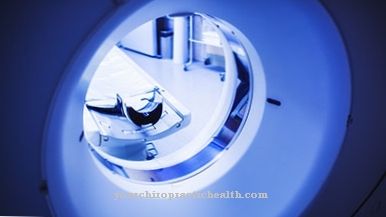The Hartnup disease is a rare and autosomal recessive hereditary metabolic disease that blocks the transport of amino acids in cell membranes through an allele mutation. The disease is extremely variable and can affect the skin, kidneys, liver, but also the central nervous system.
What is Hartnup Disease?

© hui_u - stock.adobe.com
Under Hartnup's disease or even that Hartnup syndrome Medicine understands a metabolic disorder that affects the transport of amino acids across cell membranes. It is a hereditary disease that is passed on in an autosomal recessive manner. This means that both homologous chromosomes must carry the defective allele in order for the disease to break out. Therefore, Hartnup's disease is rather rare.
Not all carriers of the gene develop symptoms at all. Because up to six different gene variants are affected by the disease, the metabolic disorder is extremely variable. For example, the disease can only manifest itself in a difficulty in transporting amino acids in the kidneys, but it can also only affect the intestines.
The disease is often compared to what is known as pellagra, a hypovitaminosis due to malnutrition that causes similar symptoms. The disease was first documented in 1956 in children of the Hartnup family in London. Today experts assume that Julius Caesar suffered from the metabolic disorder.
causes
The cause of Hartnup syndrome is a gene mutation. In this context, medicine assumes a total of 21 different mutations of SLC6A19 in chromosome five gene locus p15.33, each of which has different effects on the transport of amino acids in the body.
As a rule, patients with Hartnup's syndrome suffer from two different mutations, most of which have the D173N allele as a gene carrier. Mutations of the D173N or P265L alleles show transport channels that are directly dependent on ACE2 in the intestine or Tmem27 in the kidneys.
The genetic defect leads to a deficiency of certain membrane proteins in the body, which in healthy people appear as neutral amino acid transporters. These amino acid transporters channel both neutral and aromatic amino acids through the body's cells. The effects of the genetic defect appear most clearly in body tissue with increased uptake of amino acids, although they are basically not limited to these tissues.
Symptoms, ailments & signs
Hartnup's disease manifests itself in a wide variety of symptoms, depending on its severity, and progresses in a series of phases. Fever, stress, and medication in particular can trigger a flare-up. Erythematous eczema, i.e. special skin lesions, appear on the skin during an attack. The gastrointestinal tract is affected by symptoms such as recurring or even persistent diarrhea.
Under certain circumstances, accompanied by psychiatric disorders, neurological symptoms such as ataxia or paralysis may occur, but these usually regress again. In most cases, the immune system in particular is permanently damaged, so that those affected by Hartnup syndrome, for example, get sick more quickly.
That being said, hypersensitivity to insulin can be symptomatic of the disease. The same goes for anatomical damage to the adrenal glands or liver. Headaches and photosensitivity may also occur during an illness flare-up.
Diagnosis & course
Since Hartnup's disease is variable, it is difficult to make general statements about the course of the disease. Ultimately, the metabolic disorder primarily affects the upper small intestine and certain cells of the kidneys. The effects of Hartnup's disease on the kidneys usually consist of decreased absorption, i.e. an inability to keep amino acids in the bloodstream. The amino acids are lost because they accumulate in the urine instead of in the blood.
However, if the person concerned is taking in sufficient protein, then this loss is of no further concern and does not cause any symptoms. Since those affected by Hartnup's disease often have a resorption disorder in the small intestine, there are usually serious losses overall, because certain essential amino acids are simply necessary for life and a healthy body gains a large part of these vital substances in the intestine through amino acid recycling .
If left untreated, Hartnup syndrome therefore often leads to serious damage and can even be fatal. Nevertheless, medicine today by and large assumes a rather benign course of the disease, since suitable treatment methods are available to compensate for the loss of amino acids, even for severe cases of the urinary surgeon syndrome. Detecting the disease is relatively difficult due to the many mutations.
Doctors usually order a urinalysis if the genetic defect is suspected, which may confirm the presence of amino acids in the urine and thus secure the first suspicion. If the first suspicion cannot be confirmed by the urine sample, the disease is not necessarily excluded. In this case, reliable diagnostics using blood values is difficult or even impossible.
Under certain circumstances, however, a test for porphyrogens can provide evidence in which hydrochloric acid is added to the morning urine. If the urine is then warmed up, porphyrogens develop a red color, which corresponds to a positive test result. However, this test is also rather unspecific.
Complications
Hartnup's disease can affect various internal organs in the body, causing discomfort or complications. In most cases, however, the liver, kidneys, and skin are affected by Hartnup's disease. Furthermore, there may be restrictions and complaints in the central nervous system. The patient suffers primarily from stress and fever.
Diarrhea also occurs, which can often be accompanied by vomiting and severe nausea. The impairment of the central nervous system sometimes leads to paralysis or sensitivity disorders in the patient. These can also lead to psychological complaints and depression. The patient's immune system is usually weakened by Hartnup's disease, so that inflammations and various infections develop more often.
Damage to the liver and kidneys occurs. In the worst case, the patient suffers from complete renal insufficiency and is therefore dependent on dialysis or a donor organ. The symptoms of Hartnup's disease are treated with medication. There are no further complications. Psychological measures are also usually necessary.
When should you go to the doctor?
Unfortunately, the symptoms of Hartnup's disease are not particularly specific and there is no general prediction of when to see a doctor. The symptoms often appear in episodes, which can indicate the disease. This usually results in severe diarrhea or other symptoms in the stomach and intestines. Skin problems can also indicate Hartnup's disease and should be investigated.
Furthermore, paralysis is a typical symptom of the disease, the severity of which can be very different. Those affected often suffer from a weakened immune system and relatively often get sick or suffer from infections and inflammations.
In some cases, Hartnup's disease can also lead to high sensitivity to insulin, which should also be investigated. The first examination can be done by a pediatrician or a general practitioner.Since the disease cannot be completely cured and is only treated symptomatically, the general practitioner can usually also perform this treatment.
Doctors & therapists in your area
Treatment & Therapy
Hartnup disease patients are usually treated with substitution therapy. This means that they are provided with a daily nutritional supplement in the form of niacin. In the initial phase, they take up to three grams of the substance daily, with the dose being regulated at 500 milligrams per day in the maintenance phase. A particularly high-protein diet with lots of tryptophan supplements this therapy method.
Dairy products, poultry, potatoes and nuts form the heart of the diet measures. If the disease is severe, these methods are not sufficient to compensate for the transport defect, so that intravenous substitutions with chemically modified amino acids have to be used. Depending on which symptoms are causing an episode of illness, in addition to ointments against the skin symptoms, physiotherapeutic measures to combat the symptoms of paralysis may also be used.
Outlook & forecast
The outlook for Hartnup's disease is different. They depend on the extent of the loss of neutral and essential amino acids. If only the kidneys are affected by the disorder, the loss can be well offset by diet. Hartnup's disease is genetic. But it develops a great deal of variability.
Several possible mutations are suspected. As a result, there is a wide range of the disease, from the lack of symptoms to the most severe symptoms. Most of those affected do not develop any symptoms and have a normal life expectancy even without treatment.
However, the severe forms of Hartnup's disease often lead to death if left untreated. Many organs in the body can be affected by decay. Neutral and aromatic amino acids are only inadequately or not at all transported through the cells due to a lack of transport proteins. They are lost from the body through excretion in the urine.
In severe cases, amino acids from degraded body cells can no longer be used at all. This can lead to the fact that essential and non-essential amino acids supplied with food are no longer sufficient for maintaining vital functions. Many organs and organ systems such as the liver, pancreas, adrenal glands, skin, intestines, central nervous system or the immune system are weakened.
The administration of niacin can in some cases improve the transport problems. In particularly severe cases of Hartnup's disease, the important amino acids must be intravenously substituted for life in order to increase life expectancy.
prevention
Hartnup's disease cannot be prevented because the metabolic disease is a hereditary genetic defect. With a prevalence of 1: 24,000, the disease is relatively rare.
Aftercare
In Hartnup's disease there are very few direct follow-up measures available to the patient. In the case of this disease, however, early detection and treatment of the disease is very important so that there are no further complications or symptoms. In the case of Hartnup's disease, those affected should consult a doctor at the first symptoms and signs to prevent the symptoms from worsening.
There can be no independent healing. The treatment of this disease is therefore, in most cases, by taking various drugs. The patient should always pay attention to the correct dosage and regular intake to alleviate the symptoms. In many cases, a change in diet is necessary, and a doctor can also create a nutrition plan.
Furthermore, some people affected by Hartnup's disease have to rely on physiotherapy to treat the symptoms. Many exercises from such a therapy can also be carried out in your own home. The loving care and support of those affected also has a positive effect on the course of this disease. Above all, this can prevent depression or mental disorders.
You can do that yourself
Since Hartnup's disease is a hereditary defect, the disease cannot usually be prevented. Those affected are always dependent on treatment by a doctor. For this reason, there is no direct possibility of self-help in the event of the illness.
In most cases, those affected are dependent on substitution therapy to relieve the symptoms. Care must be taken to ensure that it is taken regularly and correctly dosed. In case of doubt, a doctor must always be consulted.
A diet with tryptophan can also have a very good effect on Hartnup's disease. For this reason, potatoes, poultry and dairy products are particularly suitable. Nuts are also an important part of this diet. Should paralysis or sensory disturbances occur, these are usually treated therapeutically. These exercises can often be done at home to help speed up the healing process for Hartnup's disease.
In the case of severe paralysis, however, those affected are dependent on loving support in their everyday life. Contact with other sufferers of the disease may prevent psychological problems.

.jpg)

.jpg)
.jpg)






















